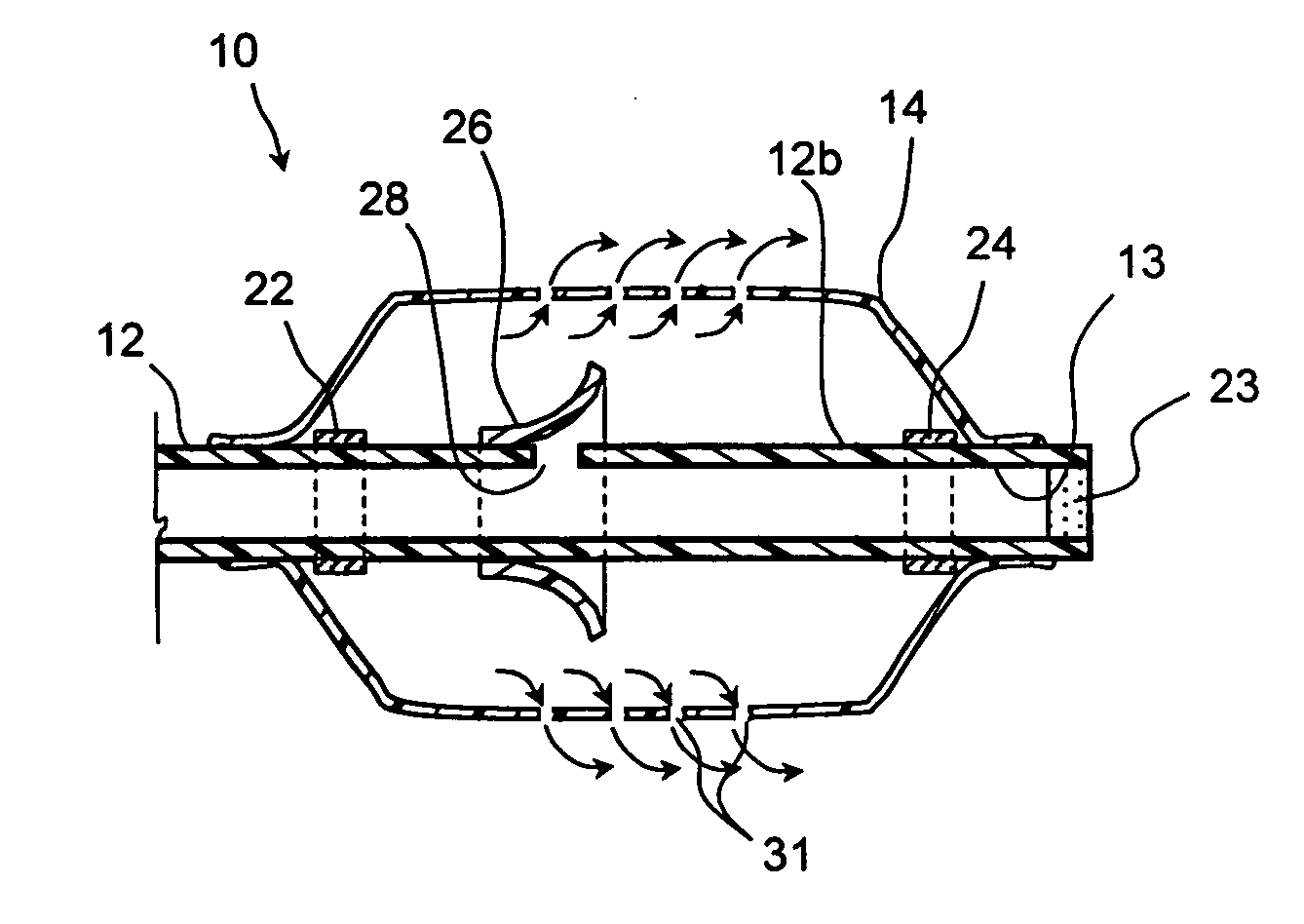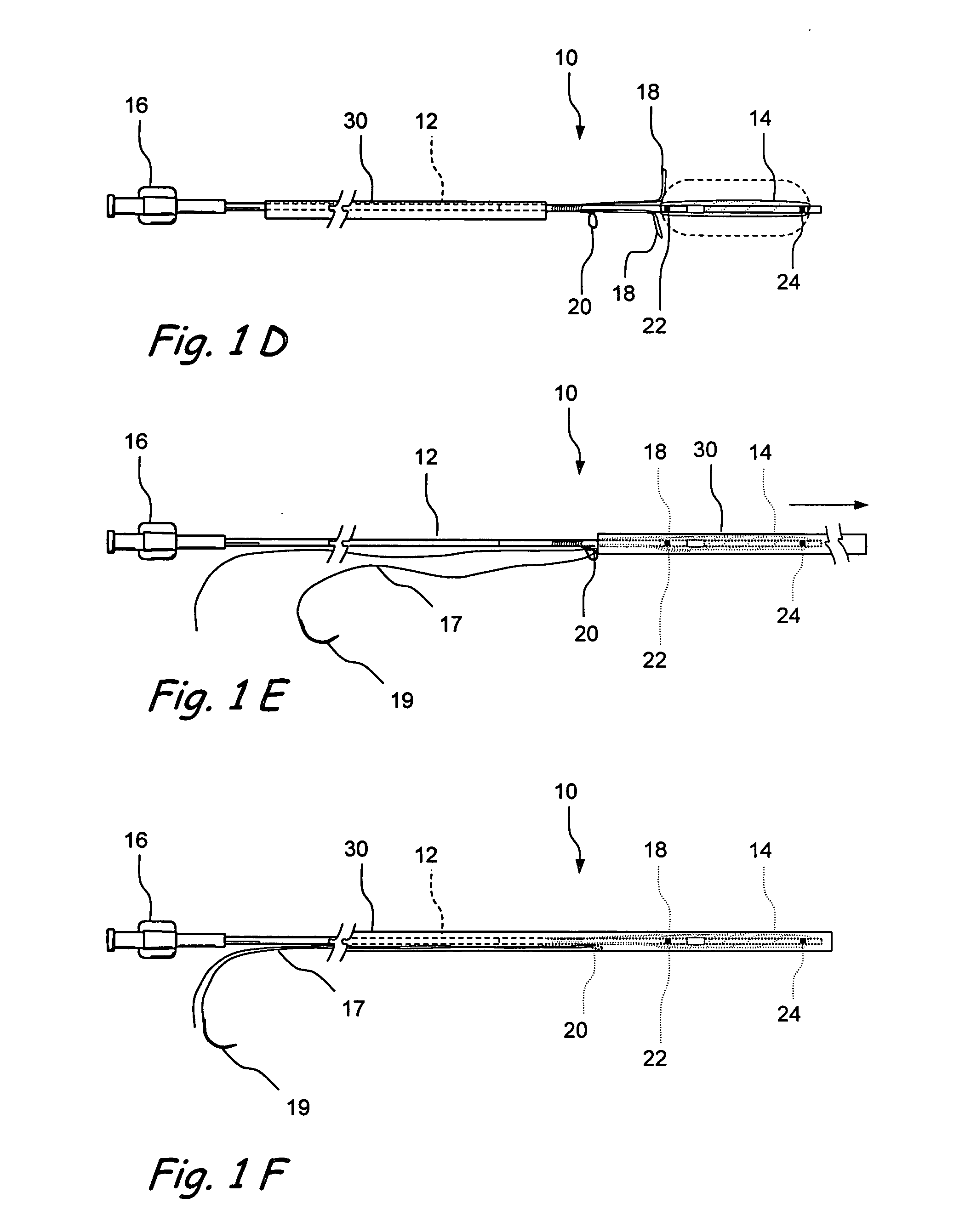[0015]Various embodiments of the present invention provide for the low profile delivery of an implantable substance delivery device and / or spacer. In one aspect of the present invention, a small
diameter hole is made in a wall to a
sinus cavity with a trocar-tipped needle which minimizes trauma to the tissue and underlying bone. A sheath is left in place in the hole to allow for the low profile introduction of an uninflated implantable substance delivery device and / or spacer. The uninflated implantable substance delivery device is passed through the sheath to a location within a sinus or
air cell. The sheath is withdrawn and the substance delivery device and / or spacer is expanded in situ by injecting a substance through a fill tube. The substance delivery device and / or spacer is left in the sinus or
air cell for
sustained delivery of a desired substance.
[0017]Further in accordance with an embodiment of the invention, there is provided an implantable device which may be used to deliver a diagnostic or therapeutic substance to any desired location within the body of a human or
animal subject, including but not limited to locations within the nose,
throat, paranasal sinus or ear. This device initially has a relatively small cross-sectional profile for delivery to the desired location by utilizing a fillable reservoir and deployable position maintaining member. This device comprises i) an elongate tubular shaft having a proximal end, a distal end and a lumen, ii) an expandable reservoir positioned on the tube at a location closer to its distal end than to its proximal end, said reservoir being in communication with the lumen such that a substance may be introduced through the lumen into the reservoir causing the reservoir to expand; at least a portion of said reservoir being substance-permeable such that the substance will elute from the reservoir in a therapeutically or diagnostically effective amount, and iii) at least one deployable position maintaining member that abuts, engages or attaches to an adjacent anatomical structure after being deployed to substantially maintain the reservoir at said location within the subject's body. In some embodiments, the position maintaining member may comprise a suture receiving member (e.g., a loop, slot, bar, etc.) useable for attaching the device to an adjacent anatomical structure by way of a suture or other connector (e.g., staple, clip, etc.) and / or one or more projections (e.g., arms) that protrude from the device such that they will abut or engage (e.g., frictionally engage or exert pressure upon) an adjacent anatomical structure thereby substantially holding the device at the desired implantation location. In some embodiments, the reservoir may comprise an expandable reservoir such as a sac or
balloon. In some embodiments, a plurality of reservoirs may be present. The substance may elute from the reservoir at a discrete location or region, or it may elute from substantially the entire surface of the reservoir depending on the therapeutic or diagnostic aim of the procedure. In some embodiments small holes will be
laser cut in the reservoir to allow the substance to pass out of the reservoir through such holes at a desired rate. Also, in some embodiments, the position maintaining member(s) is in a non-deployed (e.g., collapsed or stowed) position during introduction of the device into the body and may subsequently assume a deployed (e.g., extended or protruding) position to hold the device at its desired implantation location. The position maintaining member(s) in a preferred embodiment is small retention wing(s) made of nitinol wire that spring outward inside of an ethmoid
air cell, but also have a relatively light
spring force so that the device can be pulled through a small opening in the ethmoid bulla safely by reducing or eliminating damage to the bulla or bones of the ethmoid air
cell(s). Beneficially, the device can be removed in a physician's office rather than a surgical setting.
[0019]Still further in accordance with the present invention, there is provided a penetrator (e.g., a sinus needle) that is useable to create an opening (e.g., an ethmoidotomy) through which the above-described substance delivery device may be introduced into a paranasal sinus or air
cell (e.g., ethmoid air
cell). This sinus needle may be straight or angled. In applications where the needle is to be advanced through the ethmoid bulla to create an opening into one or more ethmoid air cells (e.g., an ethmoidotomy), the needle may be angled and the angle of the needle may be oriented such that the distal tip of the needle advances on a trajectory that is parallel to or diverges away from the adjacent
skull base, thereby decreasing the likelihood that the needle will inadvertently enter the cranial vault causing
cerebrospinal fluid leakage and / or
central nervous system complications. In some embodiments, this sinus needle may include a needle sheath that is initially placed over the needle as it is inserted into the paranasal sinus or air cell. Thereafter, the needle may be removed leaving the sheath in place and another device (e.g., an implantable substance delivery device such as that described above or other device) may then be introduced into the paranasal sinus or air cell through the sheath.
[0020]Still further in accordance with the present invention, there is provided an implantable substance delivery device that comprises i) a reservoir that contains the substance, such reservoir being at least partially flexible such that it may be compressed and permeable to allow the substance to elute therefrom, ii) a reservoir compressing member and iii) a pull member attached to the reservoir compressing member, said pull member being attached to the reservoir compressing member such that pulling the pull member will compress the reservoir. The present invention also includes methods for using such device to deliver a diagnostic or therapeutic substance. Such methods generally comprise the steps of i) implanting the device such that substance that elutes from the reservoir will enter the desired location, ii) placing a quantity of the substance in the reservoir such that the substance elutes from the reservoir and iii) pulling the pull member one or more times to compress the reservoir, thereby increasing the pressure of the substance within the reservoir. The invention also includes a method for using this device wherein the device is positioned at a desired location (e.g., within a paranasal sinus or air cell) and the pull member is periodically or continuously pulled, thereby compressing the reservoir and increasing the pressure of substance contained within the reservoir. In this manner, adequate pressure may be maintained within the reservoir to cause the substance to elute from the reservoir at a substantially constant or desired rate despite a decrease in the volume of substance contained within the reservoir.
 Login to View More
Login to View More  Login to View More
Login to View More 


